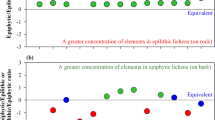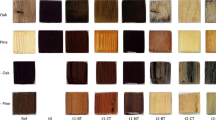Abstract
The effects of different sample preparation strategies and storage on metal(loid) fractionation trends in plant material is largely underresearched. In this study, a bulk sample of lichen Parmotrema austrosinense (Zahlbr.) Hale was analysed for its total extractable metal(loid) content by ICP-MS, and was determined to be adequately homogenous (<5% RSD) for most elements. Several subsets of this sample were prepared utilising a range of sample preservation techniques and subjected to a modified sequential extraction procedure or to total metal extraction. Both experiments were repeated after 1-month storage at 4 °C. Cryogenic freezing gave the best reproducibility for total extractable elemental concentrations between months, indicating this to be the most suitable method of sample preparation in such studies. The combined extraction efficiencies were >82% for As, Cu, Mn, Pb, Sr and Zn but poor for other elements, where sample preparation strategies ‘no sample preparation’ and ‘dried in a desiccator’ had the best extraction recoveries. Cryogenic freezing procedures had a significantly (p < 0.05) negative effect on metal extractability, and is therefore inappropriate for sequential extraction procedures in lichens. Biotransformation over a period of a month is suspected for most elements, with the exception of Sr and Zn, where changes in the fractionation patterns were statistically significant (p < 0.05), indicating the need for minimal delay in sample cleaning and preservation when species fractionation patterns are of interest. This study also shows that the assumption that species stability can be ensured through cryopreservation and freeze drying techniques needs to be revisited.







Similar content being viewed by others
Abbreviations
- BCR:
-
Bureau Community of Reference
- CRM:
-
Certified reference material
- ICP-MS:
-
Inductively coupled plasma mass spectrometry
- LOD:
-
Limit of detection
- LOQ:
-
Limit of quantification
- MDL:
-
Method detection limit
- PFA:
-
Perfluoroalkoxy alkane
- SET:
-
Sequential elution technique
- XAS:
-
X-ray absorption spectrometry
References
Bačkor, M., & Loppi, S. (2009). Interactions of lichens with heavy metals. Biologia Plantarum, 53, 214–222.
Banerjee, A. D. K. (2003). Heavy metal levels and solid phase speciation in street dusts of Delhi, India. Environmental Pollution, 123, 95–105.
Bargagli, R., Losco, F. P., & D’Amato, M. L. (1987). Zonation of trace metal accumulation in three species of epiphytic lichens belonging to the genus Parmelia. Crypotogamie, Bryologie-Lichenologie, 8, 331–337.
Bargagli, R., Monaci, F. F., Borghini, F., Bravi, F. F., & Agnorelli, C. (2002). Mosses and lichens as biomonitors of trace metals. A comparison study on Hypnum cupressiforme and Parmelia caperata in a former mining district in Italy. Environmental Pollution, 116, 279–287.
Branquinho, C., Catarino, F., Hunther, D., Joao, M., Brown, D. H., Pereira, M. J., & Soares, A. (1999). Improving the use of lichens as biomonitors of atmospheric metal pollution. Science of the Total Environment, 232, 67–77.
Brown, D. H., & Brown, R. M. (1991). Mineral cycling and lichens: the physiological basis. The Lichenologist, 23, 293–307.
Cansaran-Duman, D., Atakol, O., Atasoy, I., Kahya, D., Aras, S., & Beyaztaş, T. (2009). Heavy metal accumulation in Pseudevernia furfuracea (L.) Zopf from the Karabük iron-steel factory in Karabük, Turkey. Zeitschrift fur Naturforschung - Section C Journal of Biosciences, 64, 717–723.
Carreras, H. A., & Pignata, M. L. M. L. (2002). Biomonitoring of heavy metals and air quality in Cordoba City, Argentina, using transplanted lichens. Environmental Pollution, 117, 77–87.
de Bruin, M. (1990). Applying biological monitors and neutron activation analysis in studies of heavy-metal air pollution. International Atomic Energy Agency Bulletin, 32, 22–27.
Demiray, A. D., Yolcubal, I., Akyol, N. H., & Çobanoǧlu, G. (2012). Biomonitoring of airborne metals using the lichen Xanthoria parietina in Kocaeli Province, Turkey. Ecological Indicators, 18, 632–643.
Eiche, E., Bardelli, F., Nothstein, A. K., Charlet, L., Göttlicher, J., Steininger, R., et al. (2015). Selenium distribution and speciation in plant parts of wheat (Triticum aestivum) and Indian mustard (Brassica juncea) from a seleniferous area of Punjab, India. Science of the Total Environment, 505, 952–961.
Farinha, M. M., Šlejkovec, Z., van Elteren, J. T., Wolterbeek, H. T., & Freitas, M. C. (2004). Arsenic speciation in lichens and in coarse and fine airborne particulate matter by HPLC–UV–HG–AFS. Journal of Atmospheric Chemistry, 49, 343–353.
Feng, X. D., Dang, Z., Huang, W. L., & Yang, C. (2009). Chemical speciation of fine particle bound trace metals. International Journal of Environmental Science & Technology, 6, 337–346.
Fernández Espinosa, A. J., Ternero Rodríguez, M., Barragán De La Rosa, F. J., Jiménez Sánchez, J. C., Rodr, M. T., Fern, A. J., et al. (2002). A chemical speciation of trace metals for fine urban particles. Atmospheric Environment, 36, 773–780.
Forbes, P. B. C., Thanjekwayo, M., Okonkwo, J. O., Sekhula, M., & Zvinowanda, C. (2009). Lichens as biomonitors for manganese and lead in Pretoria, South Africa. Fresenius Environmental Bulletin, 18, 609–614.
Forbes, P. B. C., van der Wat, L., & Kroukamp, E. M. (2015). Biomonitors. In Comprehensive analytical chemistry (Vol. 70, pp. 53–108). Amsterdam: Elsevier.
Frati, L., Brunialti, G., & Loppi, S. (2005). Problems related to lichen transplants to monitor trace element deposition in repeated surveys: a case study from central Italy. Journal of Atmospheric Chemistry, 52, 221–230.
Gailey, F. A. Y., Smith, G. H., Rintoul, L. J., & Lloyd, O. L. (1985). Metal deposition patterns in central Scotland, as determined by lichen transplants. Environmental Monitoring and Assessment, 5, 291–309.
Gandois, L., Agnan, Y., Leblond, S., Séjalon-Delmas, N., Le Roux, G., & Probst, A. (2014). Use of geochemical signatures, including rare earth elements, in mosses and lichens to assess spatial integration and the influence of forest environment. Atmospheric Environment, 95, 96–104.
Giordano, S., Adamo, P., Sorbo, S., & Vingiani, S. (2005). Atmospheric trace metal pollution in the Naples urban area based on results from moss and lichen bags. Environmental Pollution, 136, 431–442.
Glenn, M. G., Orsi, E. V., & Hemsley, M. E. (1991). Lichen metal contents as correlates of air filter measurements. Grana, 30, 44–47.
Godinho, R. M., Wolterbeek, H. T., Verburg, T., & Freitas, M. C. (2008). Bioaccumulation behaviour of transplants of the lichen Flavoparmelia caperata in relation to total deposition at a polluted location in Portugal. Environmental Pollution, 151, 318–325.
González-Miqueo, L., Elustondo, D., Lasheras, E., & Santamaría, J. M. (2010). Use of native mosses as biomonitors of heavy metals and nitrogen deposition in the surroundings of two steel works. Chemosphere, 78, 965–971.
Gräfe, M., Donner, E., Collins, R. N., & Lombi, E. (2014). Speciation of metal(loid)s in environmental samples by X-ray absorption spectroscopy: a critical review. Analytica Chimica Acta, 822, 1–22.
Hanedar, A. (2015). Assessment of airborne heavy metal pollution in soil and lichen in the Meric-Ergene Basin, Turkey. Environmental Technology, 36, 2588–2602.
Hauck, M., Mulack, C., & Paul, A. (2002). Manganese uptake in the epiphytic lichens Hypogymnia physodes and Lecanora conizaeoides. Environmental and Experimental Botany, 48, 107–117.
Hjorth, T. (2004). Effects of freeze-drying on partitioning patterns of major elements and trace metals in lake sediments. Analytica Chimica Acta, 526, 95–102.
Jamali, M. K., Kazi, T. G., Arain, M. B., Afridi, H. I., Jalbani, N., Kandhro, G. A., et al. (2009). Speciation of heavy metals in untreated sewage sludge by using microwave assisted sequential extraction procedure. Journal of Hazardous Materials, 163, 1157–1164.
Jeran, Z., Jaćimović, R., Batič, F., Smodiš, B., & Wolterbeek, H. T. (1996). Atmospheric heavy metal pollution in Slovenia derived from results for epiphytic lichens. Fresnius Journal of Environmental Chemistry, 354, 681–687.
Keith, L. H. (1996). Compilations of EPA’s sampling and analysis methods (2nd ed.). Oxford: CRC Press: Lewis Publishers.
Krämer, U., Pickering, I. J., Prince, R. C., Raskin, I., & Salt, D. E. (2000). Subcellular localization and speciation of nickel in hyperaccumulator and non-accumulator Thlaspi species. Plant Physiology, 122, 1343–1353.
Kroukamp, E. M., Wodimu, T., & Forbes, P. B. C. (2016). Metal and metalloid speciation in plants: overview, instrumentation, approaches and commonly assessed elements. TrAC, 77, 87–99.
Kuehnelt, D., Lintschinger, J., & Goessler, W. (2000). Arsenic compounds in terrestrial organisms. IV. Green plants and lichens from an old arsenic smelter site in Austria. Applied Organometallic Chemistry, 14, 411–420.
Kularatne, K. I. A., & de Freitas, C. R. (2013). Epiphytic lichens as biomonitors of airborne heavy metal pollution. Environmental and Experimental Botany, 88, 24–32.
Laurette, J., Larue, C., Llorens, I., Jaillard, D., Jouneau, P. H., Bourguignon, J., & Carrière, M. (2012). Speciation of uranium in plants upon root accumulation and root-to-shoot translocation: a XAS and TEM study. Environmental and Experimental Botany, 77, 87–95.
Li, J., Lu, Y., Shim, H., Deng, X., Lian, J., Jia, Z., & Li, J. J. (2010). Use of the BCR sequential extraction procedure for the study of metal availability to plants. Journal of Environmental Monitoring, 12, 466–471.
Loppi, S., & Pirintsos, S. A. (2003). Epiphytic lichens as sentinels for heavy metal pollution at forest ecosystems (central Italy). Environmental Pollution, 121, 327–332.
Madrid, Y., & Cámara, C. (1997). Biological substrates for metal preconcentration and speciation. TrAC-Trends in Analytical Chemistry, 16, 36–44.
Michalke, B. (2003). Element speciation definitions, analytical methodology, and some examples. Ecotoxicology and Environmental Safety, 56, 122–139.
Milestone Application Note HPR-FO-55 (2014) Lichen, Rev 05_11, accessed from www.milestonesrl.com.
Monaci, F., Fantozzi, F., Figueroa, R., Parra, O., & Bargagli, R. (2012). Baseline element composition of foliose and fruticose lichens along the steep climatic gradient of SW Patagonia (Aisén region, Chile). Journal of Environmental Monitoring, 14, 2309–2316.
Monnet, F., Bordas, F. F., Deluchat, V. V., Chatenet, P., Botineau, M., & Baudu, M. (2005). Use of the aquatic lichen Dermatocarpon luridum as bioindicator of copper pollution: accumulation and cellular distribution tests. Environmental Pollution, 138, 455–461.
Ng, O.-H., Tan, B. C., & Obbard, J. P. (2005). Lichens as bioindicators of atmospheric heavy metal pollution in Singapore. Environmental Monitoring and Assessment, 123, 63–74.
Paoli, L., Guttová, A., Grassi, A., Lackovičová, A., Senko, D., & Loppi, S. (2014). Biological effects of airborne pollutants released during cement production assessed with lichens (SW Slovakia). Ecological Indicators, 40, 127–135.
Pérez-Llamazares, A., Ángel Fernández, J., Carballeira, A., & Aboal, J. R. (2011). The sequential elution technique applied to cryptogams: a literature review. Journal of Bryology, 33, 267–278.
Pollard, A. S., Williamson, B. J., Taylor, M., Purvis, W. O., Goossens, M., Reis, S., et al. (2015). Integrating dispersion modelling and lichen sampling to assess harmful heavy metal pollution around the Karabash copper smelter, Russian Federation. Atmospheric Pollution Research, 6, 939–945.
Sánchez-Moreno, R. A., Gismera, M. J., Sevilla, M. T., & Procopio, J. R. (2010). Direct and rapid determination of ultratrace heavy metals in solid plant materials by ET-AAS ultrasonic-assisted slurry sampling. Phytochemical Analysis, 21, 340–347.
Tessier, A., Campbell, P. G. C., & Bisson, M. (1979). Sequential extraction procedure for the speciation of particulate trace metals. Analytical Chemistry, 51, 844–851.
Tokahoğlu, Ş., & Kartal, Ş. (2004). Bioavailability of soil-extractable metals to tea plant by BCR sequential extraction procedure. Instrumentation Science & Technology, 32, 387–400.
Ure, A. (2002). Chemical speciation in the environment (2nd ed.). Oxford: Blackwell Science.
Acknowledgements
The financial assistance of the University of Pretoria and the University of Johannesburg towards this research is hereby acknowledged. The authors would like to thank Johannesburg City Parks and Zoo for allowing the sampling to take place on their premises and PerkinElmer South Africa for their continued support of this project. Opinions expressed and conclusions arrived at are those of the authors and are not necessarily to be attributed to these Universities.
Author information
Authors and Affiliations
Corresponding author
Ethics declarations
Conflict of interest
The authors declare that they have no conflict of interest.
Rights and permissions
About this article
Cite this article
Kroukamp, E.M., Godeto, T.W. & Forbes, P.B.C. Comparison of sample preparation procedures on metal(loid) fractionation patterns in lichens. Environ Monit Assess 189, 451 (2017). https://doi.org/10.1007/s10661-017-6155-4
Received:
Accepted:
Published:
DOI: https://doi.org/10.1007/s10661-017-6155-4




